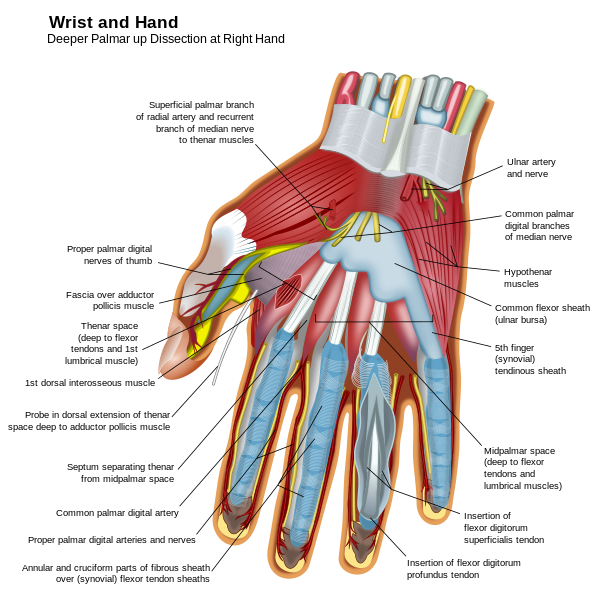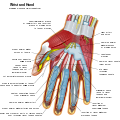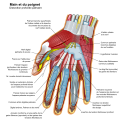Setshwantsho:Wrist and hand deeper palmar dissection-en.svg

Size of this PNG preview of this SVG file: 602 × 600 pixels. Tse dingwe resolutions: 241 × 240 pixels | 482 × 480 pixels | 771 × 768 pixels | 1,028 × 1,024 pixels | 2,056 × 2,048 pixels | 770 × 767 pixels.
Faele ya konokono (SVG file, nominally 770 × 767 pixels, file size: 805 KB)
Segologolo sa setshwantsho
Tbetsa letsatsi/nako go bone faele jaaka ene e ntse ka nako eo.
| Letsatsi/Nako | Thumbnail | Dikarolwana | Modirisi | Comment | |
|---|---|---|---|---|---|
| ya jaanong | 20:16, 31 Mopitlo 2009 |  | 770 × 767 (805 KB) | Wilfredor | Right hand especification |
| 20:08, 31 Mopitlo 2009 |  | 770 × 767 (805 KB) | Wilfredor | Palmar up especification and annular correction | |
| 21:29, 23 Phukwi 2008 |  | 770 × 767 (805 KB) | Bibi Saint-Pol | {{Created with Inkscape}} == {{int:filedesc}} == {{Information |Description= {{en|The hands (med./lat.: manus, pl. manūs) are the two intricate, prehensile, multi-fingered body parts normally located at the end of each arm of a human or other primate. Th | |
| 02:46, 19 Phukwi 2008 |  | 770 × 767 (805 KB) | Wilfredor | {{Information |Description= |Source= |Date= |Author= |Permission= |other_versions= }} | |
| 02:41, 19 Phukwi 2008 |  | 770 × 767 (805 KB) | Wilfredor | {{Information |Description= |Source= |Date= |Author= |Permission= |other_versions= }} | |
| 15:31, 18 Phukwi 2008 |  | 770 × 767 (805 KB) | Wilfredor | {{Information |Description= |Source= |Date= |Author= |Permission= |other_versions= }} | |
| 14:59, 18 Phukwi 2008 |  | 770 × 767 (805 KB) | Wilfredor | == Summary == {{Information |Description={{en|1=The hands (med./lat.: manus, pl. manūs) are the two intricate, prehensile, multi-fingered body parts normally located at the end of each arm of a human or other primate. They are the chief organs for physic | |
| 14:45, 18 Phukwi 2008 |  | 770 × 767 (805 KB) | Wilfredor | {{Information |Description={{en|1=The hands (med./lat.: manus, pl. manūs) are the two intricate, prehensile, multi-fingered body parts normally located at the end of each arm of a human or other primate. They are the chief organs for physically manipulat |
Tiriso ya setshwantsho
There are no pages that use this file.
Tiriso ya file ka karetso
Di wiki tse dingwe di dirisa setshwantsho se
- Dirisa mo bo.wikipedia.org
- Dirisa mo dv.wikipedia.org
- Dirisa mo en.wikipedia.org
- Muscles of the hand
- Hand
- Wikipedia talk:WikiProject Medicine/Archive 12
- Wikipedia:Featured picture candidates/Wrist and hand deeper palmar dissection-en.svg
- Wikipedia:Featured picture candidates/April-2009
- Wikipedia:Featured picture candidates/December-2009
- Wikipedia:Featured picture candidates/Wrist and hand deeper palmar dissection
- Dirisa mo en.wikibooks.org
- Dirisa mo hr.wiktionary.org
- Dirisa mo hu.wikipedia.org
- Dirisa mo incubator.wikimedia.org
- Dirisa mo pnb.wikipedia.org
- Dirisa mo pnb.wiktionary.org
- Dirisa mo te.wikipedia.org
- Dirisa mo vi.wikipedia.org







